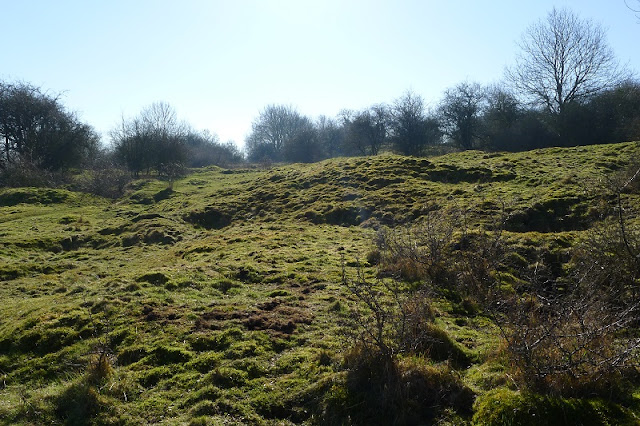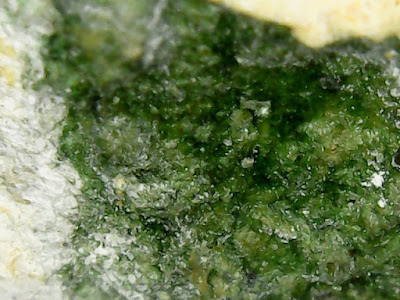I made two trips to this locality over the 26th and 27th February, 2019. It's situated between Wirksworth and Cromford on the high ground overlooking Dean Quarry to the left of Porter Lane and the Wirksworth Cromford road (B5036) intersection.
The site is now managed as a nature reserve by Derbyshire Wildlife Trust and access to the reserve is via the entrance to Dark Lane. This is off Porter Lane, on the right hand side just after the entrance to the Adventure Centre on the left hand side. There is possibly room to park here but I chose to park in the car park just up the road at the National Stone Centre and walked from there.
Background
Lead had been mined in the Wirksworth area since Roman times and this
area was one of the first productive Lead mining areas in Derbyshire.
Repton Abbey owned mines at Wirksworth in the 800s AD and Lead mining
was an established industry by 1086 when mines in the area were recorded
in the Doomsday Book. In 1540 144 tons of Lead was mined at Deans
Hollow between Wirksworth and Cromford.
The Dovegang mines were named after the Dove Gange (Dovegang) vein which
ran in an east to west direction from Black Rocks over to Middleton.
With it's tributary veins it covered an area of about 200 acres. In
1632 records clearly show a shaft known as the Gyn Pitt and with a
shaft apparently 240 foot deep. There were problems with flooding
which was not solved until the introduction of Derbyshire's first sough
(drainage system) in the 1630's and improved upon by many more that
followed.
There appear to have been many shafts dug across the area through the
ages with other names such as California mine and Sliding Pits mine.
The 'Lead Miners Heyday: the great days of Lead mining in Wirksworth and the Low Peak of Derbyshire'
document (a link provided in the reference section) is a fascinating
history of mining in the area and full of interesting detail including
the somewhat dubious acquisition in the 1600s of the Dovegang mines by
the then Attorney General Sir Robert Heath and the removal of the locals
mining rights.
Mineralogy
I have been unable to find any detailed information on minerals found at
these mines. It goes without saying that the primary Lead mineral was
Galena.
Minerals found
The area contains some of the oldest mine workings in Derbyshire and as
such appear to have been been heavily picked over the years. Specimens
were hard to find and being a nature reserve I did not want to disturb
the spoil heaps. However, I did manage to find a few samples as
follows:
Galena
Pyromorphite
Smithsonite
Fluorspar
Baryte
Some useful references
Derbyshire Wildlife Trust: Gang mine
Lead Miners Heyday pdf
Wikipedia: Derbyshire Lead Mining History
Gang Vein and Gulf Fault
 |
| SIGNAGE AT ENTRANCE |
 |
| LANE TO DOVEGANG MINES |
 |
| ENTRANCE STYLE |
 |
| SPOIL HEAPS IN THE AREA OF GYN PITT |
 |
| ANOTHER VIEW |
 |
| COVERED SHAFT |
| OLD WORKINGS AT EDGE OF SITE NEAR DEAN QUARRY |
| DEAN QUARRY |
| CAPPED SHAFT NEAR CALIFORNIA MINE |
| VIEW ACROSS THE FIELDS TO MIDDLETON FROM THE WEST OF THE SITE |
| VIEW ACROSS TO BLACK ROCKS FROM THE EAST OF THE SITE |
| OLD LIME KILN LOCATED DOWNHILL TO THE EAST, IDENTIFIED FROM AN 1884 OS MAP |
 |
| GALENA AND BARYTE |
| PYROMORPHITE |
| PYROMORPHITE - SAME SAMPLE VIEWED WITH THE DIGITAL MICROSCOPE |
 |
| SMITHSONITE |
 |
| SMITHSONITE - THROUGH THE MICROSCOPE |
 |
| FLUORSPAR - FROM THE CALIFORNIA MINE AREA |
| ENCRUSTED FLUORSPAR CUBES FROM THE GYN PIT SPOIL HEAPS |









No comments:
Post a Comment